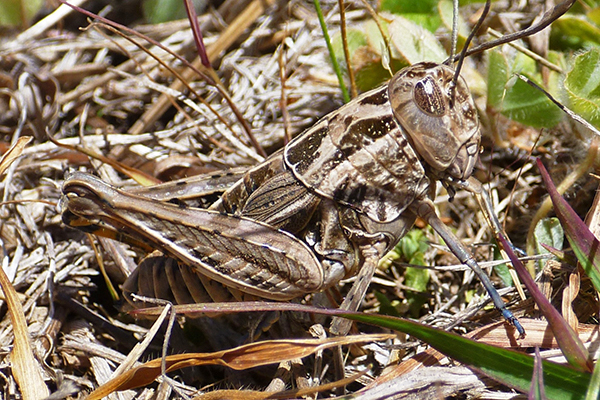Perunga Grasshopper (Perunga ochracea)
 The native Perunga Grasshopper (Perunga ochracea) was declared an endangered species in the ACT in 1997 and has special protection status.
The native Perunga Grasshopper (Perunga ochracea) was declared an endangered species in the ACT in 1997 and has special protection status.
The species appears to have a small range stretching 180 km east–west and 150 km north–south and including Murrumbateman, Gundaroo, the ACT and Bungendore. However, the area of occupancy within much of this range is likely to be low because habitat alteration and fragmentation have reduced or destroyed populations.
Approximately 99.5% of Natural Temperate Grassland in Australia has been destroyed or drastically altered since European settlement. The Perunga Grasshopper is mostly restricted to larger areas of remnant habitat.
This small grasshopper is characterised by a pale cross on the upper side of the thorax and vestigial wings. The species is flightless—but it can leap more than a metre. Females are about 30 millimetres long and males about half that. The colours on its back can vary from year to year, with a tendency toward grey-brown in dry years and greenish in wet years.
Nymphs hatch in late summer and autumn and develop over the winter and early spring. They only have a 12-month cycle. The grasshoppers eat forbs (small flowering plants).
In the ACT, the grasshopper has been found in Natural Temperate Grassland dominated by wallaby grasses, speargrasses or Kangaroo Grass, and in other native grasslands. Field observations suggest the species uses grass tussocks as shelter spaces, and likes sites containing vegetation mosaics with tall tussock grasses, shorter grasses and forbs and bare ground.
Conservation threats
The major threats to the Perunga Grasshopper are:
- loss and fragmentation of habitat through clearing of native grasslands for urban, industrial and infrastructure development and for agricultural purposes
- modification and degradation of native grassland habitat, particularly through weed invasion, cultivation and pasture improvement, overgrazing or close mowing, excessive vegetation biomass, wildfire or inappropriate fire regimes, and predation by domestic, wild and native animals
- major ecological disturbances to grassland habitat such as widespread (unplanned) fire, drought and climate change.
Habitat fragmentation and degradation will exacerbate any effects on populations from climate change, which is expected to bring warmer year-round temperatures with fewer frosts, more hot days and warm spells, and declining rainfall (especially in winter). Insects and lizards have a limited ability to physiologically acclimate to higher temperatures, and species that are close to their heat tolerance limit will be most at risk from climate change.
Because the grasshoppers are flightless and live alone in a low density environment, genetic diversity is unlikely, which may threaten the species. More research is needed on this.
Conservation actions
The long-term conservation of the Perunga Grasshopper depends on protecting its native grassland and grassy woodland habitat.
Through the Perunga Grassland Action Plan (2017), which continues the 2006 action plan, and the ACT Native Grassland Conservation Strategy (2017), the ACT Government proposes to maintain the conditions, in the long term, that encourage a viable, wild population.
The overall conservation objectives include:
- conserve important ACT populations
- manage the species and its habitat to maintain the potential for evolutionary development in the wild, particularly through mowing or grazing, removal of weeds, patch burning and creation of a diverse habitat structure
- enhance the long-term viability of populations through management of adjacent grassland to increase habitat area and connect populations
- provide offset areas, with management plans, for areas subject to urban development.
- continue extensive survey, monitoring and research
- collaborate with research institutions and non-government organisations and encourage citizen science and volunteers.
The species is hard to detect and monitor and little is known about the distribution and abundance of the species within sites, or its ecology and biology. Research is needed on all aspects of its biology, lifecycle and ecological requirements.
Where the species occurs on Commonwealth land, the ACT Government will continue to liaise with the Australian Government Department of Defence and Canberra Airport to encourage continued protection and management.
Maintaining a varied grassland structure and avoiding herbage biomass extremes appear to be the best conditions for the grasshopper. Structural variety suggests that low to moderate kangaroo grazing may favour the species. Results from a grassland enhancement trial at Canberra International Airport suggest that a sparse population can respond strongly to improved conditions.
For an improved understanding of the species, the ACT Government will continue to collaborate with other states, universities, CSIRO, Australian National Botanic Gardens, other research institutions and non-government organisations. Monitoring will continue to determine long-term population trends and evaluate the effects of management.
More information
Contact
Phone Access Canberra on 13 22 81 or email environment@act.gov.au.

